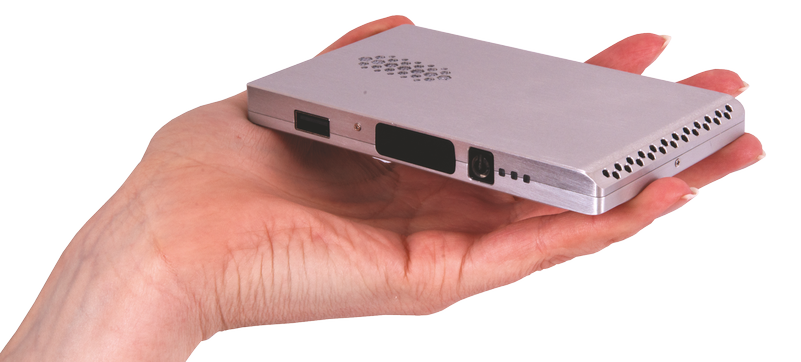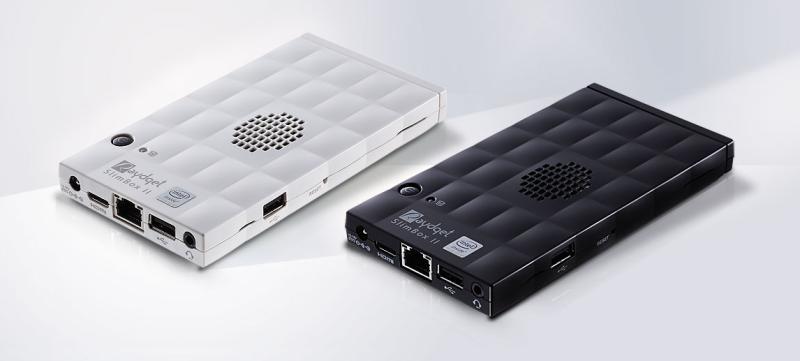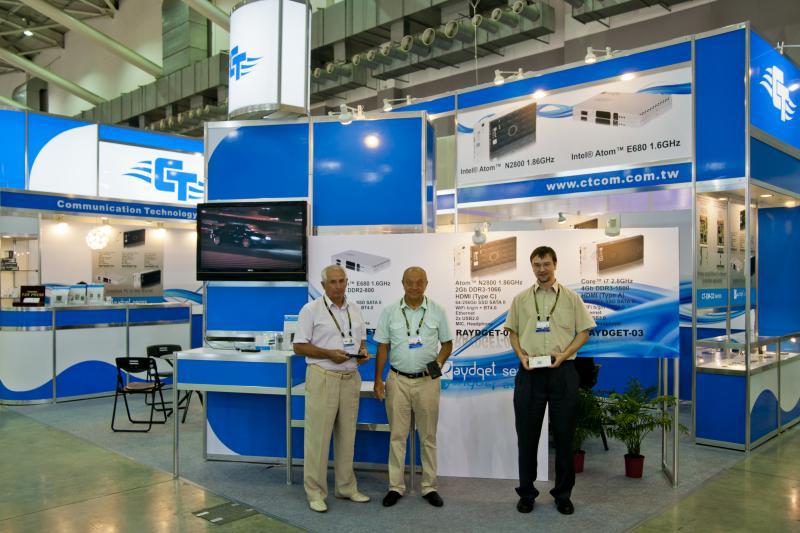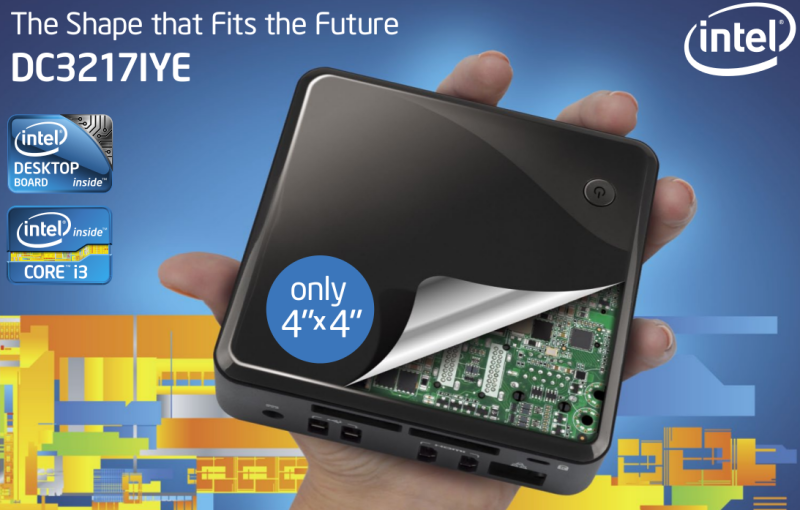Desktop on the palm
Russian company CJSC Network Technologies and its branch in Taiwan Communication Technology Ltd. At the upcoming Computex 2014, held from June 3rd to June 7th in Taipei, there are three minicomputers based on the Cedar Trail platforms - Atom N2000, Chief River - 3rd gen Core i3 / i5 / i7 and Shark Bay - 4th gen Core i3 / i5 / i7.

The history of our company is quite voluminous, it began in the 80s of the last century with the help of an enthusiastic team of engineers who gathered in the basements of the university. The team was engaged in the development of the first personal computers in 1988. was created the first computer called "Irisha". In 91 years, the company began to develop a second line of activity - the development and production of switching equipment, and in 93rd year it opened a third direction - the creation of radio mobile communications for the power structures of the Russian Federation. Currently, the company has a main office in Moscow and a subsidiary in Taipei.
As is often the case, the story goes in a spiral, and in 2012 the company again took up the development of personal computers. The basis was chosen as the world leader in the production of Intel processors. At once I will say that all development was carried out exclusively by our engineers, from the development of the circuit (quite a large change in the reference circuitry from Intel) to the soldering of the boards. Pilot production is organized on its own, its own SMD line in the Taiwan office, competent supply and a large number of business partners around the world. Well, anticipating the cries that it’s all Chinese, we bought and sold (at first it was, especially on 3Dnews), it’s all marketers writing, etc. - I am one of the main developers of these minicomputers, I live and work in Taiwan, and by the way, I am writing this post from the Raydget SlimBox III minicomputer right now.
')
The first motherboard we launched was a module for embedded COMExpress form factor systems based on the Pine Trail platform. Those. a 200 by 200 kerchief with an Atom 400th and 500th series processor and an NM10 chipset. There was nothing extraordinary in this board, it can be said it was a sample of the pen, debugging the production of the board, debugging of the circuitry and wiring.
The next project was a miniature Qseven standard module based on the Queens Bay industrial platform. Atom E600 series with EG20T chipset.

The development was notable for the fact that we managed to make the module quite thin, as opposed to Portwell and Advantech. The idea arose by itself, the module itself having sufficiently small dimensions - 70 to 70, connected to a small motherboard and get a super small computer at the output.

As a result, we made a computer, 125x74x12 mm in size and weighing about 150 grams. Features were not too luxurious -
But they completely allowed themselves to turn Windows 7 without Aero, and the presence of an integrated video decoder solved the problem of playing DXVA video up to 1080p.

With the success of showing this computer in 2012 on Computex Taipei and Global Source Hong Kong. In the photo I, in the company of computer computers.

After receiving a lot of feedback from potential buyers, at the same time continuing to develop new platforms (Cedar Trail - Atom N2000, D2000 was launched at that time), they decided to make a second version of the minicomputer and Raydget brand promotion and the SlimBox minicomputer line.
So, a plastic case, a slightly larger 145x77x16mm, non-modular structure and improved performance.

Having received more reviews and deciding to reduce the price of a computer, we increased the thickness of the case and installed a slide under a regular 2.5 "HDD drive. Raydget SlimBox II is now in two versions with SSD and HDD.
Not to mention the accessories for the minicomputer, they, too, should be mini. The power supply unit, all cables and the computer itself are placed in a special bag.

And VESA bracket for mounting on the monitor.

But this is the beast machine. In Maximum Configuration:
With the ability to organize RAID from SSD, but provided that then the WiFi card is not installed. But from this I am writing a post.

Computex 2013 did not bypass us, we took part and showed the world the SlimBox II and then also the prototype SlimBox III.

Well, how to get around the new-fashioned SharkBay platform based on the Intel Haswell processor. Maximum configuration of this computer:

Since Haswell is quite economical in heat dissipation, a new model CoolBox, a computer without a fan, appears in the line.
Features differ slightly from SlimBox IV -

Basically, all mini-computers are now based on ARM processors. These are HDMI dongles, Pi-based computers, etc. On the x86 architecture of similar projects - count on fingers.
At the time of the creation of the first instance of such devices did not exist. But time does not stand still and Intel itself decided to do something similar.
Intel NUC (Next Unit of Computing). This is a form factor board, measuring 4x4 inches. Based on this form factor, GIGABYTE and ASUS computers are already doing.

Tango, a minicomputer on an AMD processor http://habrahabr.ru/post/221987/ . Everything is good, the size is similar to ours, but the bulky docking station, without which this mini PC can not be used nullifies the compact size, and it costs half of this computer.
Gigabyte Brix http://habrahabr.ru/post/222033/ . NUC form factor.
CyberPowerPC http://habrahabr.ru/post/222153/ . The same, the NUC form factor.
Coming Computex 2014.

The stand of our company is opposite ASUS. If you are going to the exhibition - be sure to come and visit our stand, we will be very happy to show and tell about our devices.
References:
" Network Technologies "
" Communication Technology "
Raydget Russia
Raydget taiwan

The history of the company "Network Technologies"
The history of our company is quite voluminous, it began in the 80s of the last century with the help of an enthusiastic team of engineers who gathered in the basements of the university. The team was engaged in the development of the first personal computers in 1988. was created the first computer called "Irisha". In 91 years, the company began to develop a second line of activity - the development and production of switching equipment, and in 93rd year it opened a third direction - the creation of radio mobile communications for the power structures of the Russian Federation. Currently, the company has a main office in Moscow and a subsidiary in Taipei.
Creating the world's smallest PC
As is often the case, the story goes in a spiral, and in 2012 the company again took up the development of personal computers. The basis was chosen as the world leader in the production of Intel processors. At once I will say that all development was carried out exclusively by our engineers, from the development of the circuit (quite a large change in the reference circuitry from Intel) to the soldering of the boards. Pilot production is organized on its own, its own SMD line in the Taiwan office, competent supply and a large number of business partners around the world. Well, anticipating the cries that it’s all Chinese, we bought and sold (at first it was, especially on 3Dnews), it’s all marketers writing, etc. - I am one of the main developers of these minicomputers, I live and work in Taiwan, and by the way, I am writing this post from the Raydget SlimBox III minicomputer right now.
')
The first motherboard we launched was a module for embedded COMExpress form factor systems based on the Pine Trail platform. Those. a 200 by 200 kerchief with an Atom 400th and 500th series processor and an NM10 chipset. There was nothing extraordinary in this board, it can be said it was a sample of the pen, debugging the production of the board, debugging of the circuitry and wiring.
The next project was a miniature Qseven standard module based on the Queens Bay industrial platform. Atom E600 series with EG20T chipset.

The development was notable for the fact that we managed to make the module quite thin, as opposed to Portwell and Advantech. The idea arose by itself, the module itself having sufficiently small dimensions - 70 to 70, connected to a small motherboard and get a super small computer at the output.

As a result, we made a computer, 125x74x12 mm in size and weighing about 150 grams. Features were not too luxurious -
| CPU | Intel Atom E680 1.6GHz |
| Memory | 1Gb DDR2-800 |
| Disk | 64-256Gb SSD mSATA |
| Wireless interfaces | WiFi b / g / n + BT 4.0 |
| Network | Ethernet 10/100/1000 |
| Audio | Mic jack + Headphone jack |
| Video | VGA D-Sub |
| Periphery | 2x USB 2.0 |
But they completely allowed themselves to turn Windows 7 without Aero, and the presence of an integrated video decoder solved the problem of playing DXVA video up to 1080p.

With the success of showing this computer in 2012 on Computex Taipei and Global Source Hong Kong. In the photo I, in the company of computer computers.

After receiving a lot of feedback from potential buyers, at the same time continuing to develop new platforms (Cedar Trail - Atom N2000, D2000 was launched at that time), they decided to make a second version of the minicomputer and Raydget brand promotion and the SlimBox minicomputer line.
Raydget SlimBox II
So, a plastic case, a slightly larger 145x77x16mm, non-modular structure and improved performance.
| CPU | Intel Atom N2800 1.86GHz |
| Memory | 4Gb DDR3-1333 |
| Disk | 64-256Gb SSD mSATA |
| Wireless interfaces | WiFi b / g / n + BT 4.0 |
| Network | Ethernet 10/100/1000 |
| Audio | Mic + Headphone jack |
| Video | mini-HDMI type C |
| Periphery | 2x USB 2.0 |

Having received more reviews and deciding to reduce the price of a computer, we increased the thickness of the case and installed a slide under a regular 2.5 "HDD drive. Raydget SlimBox II is now in two versions with SSD and HDD.
Not to mention the accessories for the minicomputer, they, too, should be mini. The power supply unit, all cables and the computer itself are placed in a special bag.

And VESA bracket for mounting on the monitor.

Raydget SlimBox III
But this is the beast machine. In Maximum Configuration:
| CPU | Intel Core i7-3537U 3.1GHz |
| Memory | 8Gb DDR3-1600 |
| Disk | 64-256Gb SSD mSATA |
| Wireless interfaces | WiFi b / g / n + BT 4.0 |
| Network | Ethernet 10/100/1000 |
| Audio | Mic + Headphone jack |
| Video | HDMI type A, WiDi |
| Periphery | 2x USB 3.0 |
With the ability to organize RAID from SSD, but provided that then the WiFi card is not installed. But from this I am writing a post.

Computex 2013 did not bypass us, we took part and showed the world the SlimBox II and then also the prototype SlimBox III.

Raydget SlimBox IV and Raydget CoolBox IV
Well, how to get around the new-fashioned SharkBay platform based on the Intel Haswell processor. Maximum configuration of this computer:
| CPU | Intel Core i7 4600U 3.3GHz |
| Memory | 8Gb DDR3L-1600 |
| Disk | 64-256Gb SSD mSATA |
| Wireless interfaces | WiFi b / g / n + BT 4.0 |
| Network | Ethernet 10/100/1000 |
| Audio | Mic + Headphone jack |
| Video | mini-HDMI type C, WiDi |
| Periphery | 2x USB 3.0 |

Since Haswell is quite economical in heat dissipation, a new model CoolBox, a computer without a fan, appears in the line.
Features differ slightly from SlimBox IV -
| CPU | Intel Core i7 4600U 3.3GHz |
| Memory | 16Gb DDR3L-1600 |
| Disk | 2.5 "HDD |
| Wireless interfaces | WiFi b / g / n + BT 4.0 |
| Network | Ethernet 10/100/1000 |
| Audio | Mic + Headphone jack |
| Video | HDMI type A, WiDi |
| Periphery | 2x USB 3.0 + USB 2.0 |

Competitors
Basically, all mini-computers are now based on ARM processors. These are HDMI dongles, Pi-based computers, etc. On the x86 architecture of similar projects - count on fingers.
At the time of the creation of the first instance of such devices did not exist. But time does not stand still and Intel itself decided to do something similar.
Intel NUC (Next Unit of Computing). This is a form factor board, measuring 4x4 inches. Based on this form factor, GIGABYTE and ASUS computers are already doing.

Tango, a minicomputer on an AMD processor http://habrahabr.ru/post/221987/ . Everything is good, the size is similar to ours, but the bulky docking station, without which this mini PC can not be used nullifies the compact size, and it costs half of this computer.
Gigabyte Brix http://habrahabr.ru/post/222033/ . NUC form factor.
CyberPowerPC http://habrahabr.ru/post/222153/ . The same, the NUC form factor.
Eventually
Coming Computex 2014.

The stand of our company is opposite ASUS. If you are going to the exhibition - be sure to come and visit our stand, we will be very happy to show and tell about our devices.
References:
" Network Technologies "
" Communication Technology "
Raydget Russia
Raydget taiwan
Source: https://habr.com/ru/post/224511/
All Articles